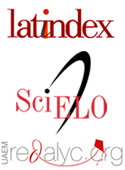A INFLUÊNCIA DO ESTOQUE DE MATÉRIA ORGÂNICA DO SOLO EM FRAGMENTOS FLORESTAIS DE MATA ATLÂNTICA
Palabras clave:
Atlantic forest, Forest Fragmentation, Organic MatterResumen
In the Atlantic forest biome, very fragmented and with high diversity of ecosystems, of species, and high endemism degree, the maintenance of the status of the biological diversity presupposes the recovery and conservation of the mosaic of existent fragments. In that context, the use of global functional indicators for the evaluation of the state of conservation of fragments, for the character of systemic synthesis that they act becomes interesting. In tropical forests ecosystems, the surface organic matter stock of the soil is one functional indicator of the decomposition subsystem and they are responsible in big measured by the maintenance and survival of the communities of those ecosystems group. The human action when fragmenting the forest ecosystems, as it substitutes the native forest for different forms of use of the soil, it creates different head offices that they exercise pressures differentiated on the fragment and, consequently, on the operation of the fundamental processes of the ecosystem that represents it. Thus, in the sense of understanding the state of functional conservation of fragments forest remainders of the Atlantic forest, in the extent of the Environmental Protection Area of Petrópolis - Rio de Janeiro, which interferes in the Mosaic of Units of Conservation of the Fluminense Central Atlantic forest and, in a larger scale still, in the Ecological Corridor of the Serra do Mar, in the present study the stock of organic matter of surface of four forest fragments in summer of 2008 and summer of 2009 are analyzed comparatively.
Descargas
Cómo citar
Número
Sección
Licencia
Política propuesta para Revistas que ofrecen Acceso Abierto
Los autores que publican en esta revista están de acuerdo con los siguientes términos:
a. Los autores conservan los derechos de autor y garantizan a la revista el derecho de ser la primera publicación del trabajo, bajo la Licencia https://creativecommons.org/licenses/by-nc-sa/4.0/deed.es, que permite a otros compartir con un reconocimiento de la autoría del trabajo y la publicación inicial en esta revista.
b. Los autores pueden establecer por separado acuerdos adicionales para la distribución no exclusiva de la versión de la obra publicada en la revista (por ejemplo, situarlo en un repositorio institucional o publicarlo en un libro), con un reconocimiento de su publicación inicial en esta revista. Esos acuerdos adicionales deben respetar los términos de la licencia: es decir: no involucrar fines de lucro y compartir con la misma licencia.
c. Se anima a los autores a archivar el post-print o versión de editor/PDF en repositorios de acceso abierto.







 REVGEO se encuentra bajo la licencia https://creativecommons.org/licenses/by-nc-sa/4.0/deed.es
REVGEO se encuentra bajo la licencia https://creativecommons.org/licenses/by-nc-sa/4.0/deed.es
.svg_4.png)

_(1).png)
_(1)_(1)_(1)_1.png)
(2)(1)(1)(1).png)
